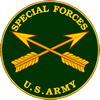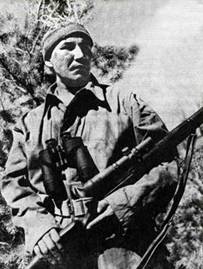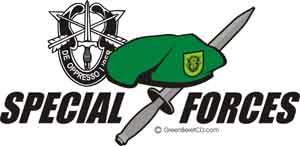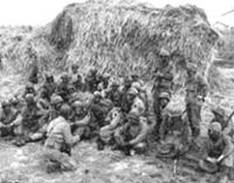By Roy Cook
 For
many thousands of American Indians Canada is known as Grandmother Country.
Regardless of National or International borders, North or South, American
Indian Warriors have always volunteered to defend this land. >From
the beginning of time, as we know it, the American continent is a Tribal
Indian home land. The Warrior tradition continues from the United States
Indian Scouts Crossed Arrows to the many cultures that are the Special
Forces Airborne of today’s USA Army.
For
many thousands of American Indians Canada is known as Grandmother Country.
Regardless of National or International borders, North or South, American
Indian Warriors have always volunteered to defend this land. >From
the beginning of time, as we know it, the American continent is a Tribal
Indian home land. The Warrior tradition continues from the United States
Indian Scouts Crossed Arrows to the many cultures that are the Special
Forces Airborne of today’s USA Army.
It is a sad fact that each year we are losing many World War II and Korean warriors to natural and service related death. This story features a Tribal warrior from Gandmother county, a highly decorated, intensely trained, unconventional warfare hero, Tommy Prince, Ojibwa.
 Thomas
George Prince was born in Petersfield, Manitoba in October of 1915. Tom
was the son of Henry and Arabella Prince of the Brokenhead Band at Scanterbury,
Manitoba. He was the Great-Great-Grandson of Chief Peguis, the Saulteax
Chief who led his band of 200 Ojibwa from the Sault Ste. Marie Region
to the Red River in the 1790's, and of Chief William Prince, who headed
the Ojibwa-Manitoba team of Nile Voyageurs. His family later moved to
the Brokenhead Reserve. He attended Elkhorn Residential School, completing
grade eight. After school he worked a variety of odd jobs, loving his
work as a lumberjack.
Thomas
George Prince was born in Petersfield, Manitoba in October of 1915. Tom
was the son of Henry and Arabella Prince of the Brokenhead Band at Scanterbury,
Manitoba. He was the Great-Great-Grandson of Chief Peguis, the Saulteax
Chief who led his band of 200 Ojibwa from the Sault Ste. Marie Region
to the Red River in the 1790's, and of Chief William Prince, who headed
the Ojibwa-Manitoba team of Nile Voyageurs. His family later moved to
the Brokenhead Reserve. He attended Elkhorn Residential School, completing
grade eight. After school he worked a variety of odd jobs, loving his
work as a lumberjack.
Like many young men on reserve, jobs were in short supply and three square meals and pocket money spoke to him. When World War II was declared Tom had to wait weeks to enlist. He was not under the threat of conscription. He was finally accepted into the Royal Canadian Engineers in 1st Corps Field Park Company, on June 3, 1940. Tom was a superb marksman with tracking skills, those he had learned on the Brokenhead Reserve while hunting. In Canada the Indian Reservations are called Reserves.
Tommy was promoted to Lance Corporal in February 1941. In September 1942
Prince returned to Canada and joined the 1st Canadian Parachute Battalion,
and was promoted to sergeant. Shortly after joining this unit it merged
with similar American units to  form
the elite First Special Service Force, later christened the Devil’s
Brigade by its enemies. Prince and the other men of this unit were chosen
for their rugged outdoor backgrounds and received a rigorous training
schedule, often under live fire. All members of this elite squad were
trained to be paratroopers and received intense instruction in stealth
tactics, hand-to-hand combat, the use of explosives for demolition, amphibious
warfare, rock climbing and mountain fighting, and as ski troops. Prince
became a “Reconnaissance Sergeant”, responsible for moving into
forward positions and reporting on the movements of the enemy.
form
the elite First Special Service Force, later christened the Devil’s
Brigade by its enemies. Prince and the other men of this unit were chosen
for their rugged outdoor backgrounds and received a rigorous training
schedule, often under live fire. All members of this elite squad were
trained to be paratroopers and received intense instruction in stealth
tactics, hand-to-hand combat, the use of explosives for demolition, amphibious
warfare, rock climbing and mountain fighting, and as ski troops. Prince
became a “Reconnaissance Sergeant”, responsible for moving into
forward positions and reporting on the movements of the enemy.
The First Special Service Force was deployed in the only campaign of World War II fought on North American soil took place in the Aleutian Island chain that stretches for a thousand miles south and west from Alaska. Although inhospitable due to ugly weather, craggy mountains, scant vegetation and remoteness, the islands became a strategic target of Japanese expansion and correspondingly important to the defense of the Western approaches to the United States. On 24 August 1943, the island was declared secure, marking the end of the Aleutian Islands Campaign. By year's end, American and Canadian troop strength in Alaska would drop from a high of about 144,000 to 113,000. By then the North Pacific Area had returned to complete Army control. During 1944 the Canadians would leave and U.S. Army strength in the Alaska Defense Command decrease to 63,000 men. Although interest in the theater waned, it was in the Aleutians that the United States won its first theater-wide victory in World War II, ending Japan's only campaign in the Western Hemisphere.
The First Special Service Force was next deployed during Operation Shingle at Anzio, Italy, 1944, the Special Force were brought ashore on February 1st, after the decimation of the U.S. Rangers and ordered to hold and raid from the right-hand flank of the beachhead marked by the Mussolini Canal/Pontine Marshes, which they did quite effectively.
Tommy Prince was at Anzio when the enemy dubbed the 1st Special Service Force as the "Devil's Brigade." The diary of a dead German soldier contained a passage that said, "The black devils (Die Schwarz Teufeln) are all around us every time we come into the line." The soldier was referring to them as "black" because the brigade's members smeared their faces with black boot polish for their covert operations in the dark of the night. Canadian and American members of the Special Force who lost their lives are buried near the beach in the Commonwealth Anzio War Cemetery and the American Cemetery in Nettuno, just east of Anzio.
Prince was part of the first units sent into Rome, the Devil’s Brigade were given the assignment of capturing seven essential bridges in the city to prevent the Germans from blowing them up. During the night of June 4th, members of the Devil’s Brigade entered Rome. After they secured the bridges, they quickly moved north in pursuit of the retreating Germans. The following morning, throngs of grateful Romans lined the streets to give the long columns of American soldiers passing through the city a tumultuous reception. War photographers captured the scenes of joy on film to be seen back home, but the Devil’s Brigade soldiers who actually liberated the city had passed through Rome during the early morning hours in darkness and near silence and were again in fierce combat with the Germans along a twenty-mile front on the Tiber River.
Tommy Prince and the Devil’s Brigade moved North into Italy as the 5th U.S. Army was preparing to capture the mountains that guarded Cassino to the south. Its initial task was to throw the Germans off two of the highest peaks, Monte la Difensa and Monte la Remetanea. Climbing ropes in the dense fog, the Force took the Germans by surprise on Difensa. Following a bloody, six-day battle, Monte la Remetanea was captured. Its first involvement in the Italian campaign cost the First Special Service Force 511 casualties, including 73 fatalities.
A month later, the Devil’s Brigade Force equaled its previous accomplishment by taking Monte Majo and several other ridges controlling the Via Caslina, the main Naples-Rome road. In terrible weather and even harsher conditions, the Germans were forced back across the Rapido River valley to their main defenses, the Gustav Line. Sixty-seven Canadian members of the Force were either killed or wounded on Monte Majo.
On February 8, 1944, near Littoria, Italy, Tommy Prince was sent forward to report the location of several German assembly points, including artillery positions. He set up in an abandoned farmhouse about 200 meters from the enemy assembly area, well behind enemy lines, with 1,400 meters of telephone wire connecting him to the force. He had a clear view of the enemy’s emplacements and promptly reported them. An artillery duel followed as the Allies attempted to knock out the guns reported by Prince, and one of these rounds cut the telephone wire. The duel died down as a result. Prince donned civilian clothing, grabbed a hoe and, in full view of German soldiers, pretended to be a farmer weeding his crops. He slowly inched his way along the line till he found where it was damaged, then, pretending to tie his shoelaces, rejoined the wires. After finishing the repairs, he made a show of shaking his fist at the nearby Germans, then again toward the Allied lines. Returning to his lookout spot, he continued his reports, and over the next 24 hours four German batteries were knocked out of action. In all he spent three days behind enemy lines. For this action, Prince was awarded the Military Medal, his citation reading (in part) “Sergeant Prince’s courage and utter disregard for personal safety were an inspiration to his fellows and a marked credit to his unit.”
The Devil’s Brigade and Tommy Prince were moved to southern France as part of Operation Dragoon. On September 1, Prince and a private were sent forward through the German lines to scout their positions near L’Escarène and came across an encampment area of an enemy reserve battalion. On the way back to report, Prince and the private came upon a battle between some Germans and a squad of French partisans. They started snipping at the Germans, who eventually withdrew. When Prince made contact with the French leader, he asked Prince where his company was located, when Prince pointed to the private and said “Here,” the French commander exclaimed that he thought there were fifty of them. The French commander recommended Prince for the Croix de Guerre, but the courier was killed en route and the message never reached the French Commander-in-Chief, Charles de Gaulle.
Prince continued on to reach the Devil’s Brigade unit. He then personally led the unit back to the encampment and joined in the battle, which resulted in the capture of the entire battalion, about 1000 men. From start to end, Prince had been without food, water or sleep for 72 hours and had walked over 70 km across rugged, mountainous terrain. Afterward, Prince was recommended for the Silver Star, his citation reading:
So accurate was the report rendered by the patrol that Sergeant Prince’s regiment moved forward on 5 September 1944, occupied new heights and successfully wiped out the enemy bivouac [encampment] area. The keen sense of responsibility and devotion to duty displayed by Sergeant Prince is in keeping with the highest traditions of the military service and reflects great credit upon himself and the Armed Forces of the Allied Nations.
As part of the U.S. 7th Army, the Devil’s Brigade fought again with
distinction in numerous battles. On September 7th, they moved to the Franco-Italian
border in what is called the "Rhineland Campaign." Members of
the Brigade, usually traveling by foot at night, made their way behind
enemy lines to provide intelligence on German positions. This operation
not only contributed to the liberation of Europe, but the information
Brigade members were able to pass back to headquarters saved many Allied
soldier's lives. When  the
fighting in southern France ended, Prince was summoned to Buckingham Palace
where King George VI pinned on the Military Medal and on behalf of President
Roosevelt, the Silver Star. In all, Tommy Prince was decorated nine times,
the most of any aboriginal soldier in the war. The war in Europe ended
while Prince was in England. Tommy was honorably discharged June 15, 1945,
and returned to Canada.
the
fighting in southern France ended, Prince was summoned to Buckingham Palace
where King George VI pinned on the Military Medal and on behalf of President
Roosevelt, the Silver Star. In all, Tommy Prince was decorated nine times,
the most of any aboriginal soldier in the war. The war in Europe ended
while Prince was in England. Tommy was honorably discharged June 15, 1945,
and returned to Canada.
The Devil's Brigade, a one-of-a-kind military unit that never failed to achieve its objective, was disbanded by the end of the War. (Photo of Tommy (R) and brother Morris Prince)
 However
the US Army, in 1952, Col. Aaron Bank would create another elite unit
using the training, the strategies, and the lessons learned from the Devil's
Brigade's missions. This force would evolve into specialized forces such
as the Green Berets, Delta Force, and the Navy SEAL. In Canada, today's
elite and highly secretive JTF2 military unit is also modeled on the Devil's
Brigade. Like World War II, Canadian JTF2 members and American Delta Force
members were united again into a special assignment force for the 2001
invasion of Afghanistan.
However
the US Army, in 1952, Col. Aaron Bank would create another elite unit
using the training, the strategies, and the lessons learned from the Devil's
Brigade's missions. This force would evolve into specialized forces such
as the Green Berets, Delta Force, and the Navy SEAL. In Canada, today's
elite and highly secretive JTF2 military unit is also modeled on the Devil's
Brigade. Like World War II, Canadian JTF2 members and American Delta Force
members were united again into a special assignment force for the 2001
invasion of Afghanistan.
In September of 1999, the main highway between the city of Lethbridge, Alberta Canada and Helena, Montana in the United States was renamed the "First Special Service Force Memorial Highway." This highway was chosen because it was the route taken in 1942 by the Canadian volunteers to join their American counterparts for training at Fort Harrison.
He worked as a lumberjack for awhile, but was bored with it. The Department of Veteran Affairs granted him funds to start a janitorial business. At this time, the Canadian Government was revising the Indian Act and the Manitoba Indian Association unanimously chose Tom Prince as Chairman. He was given extensive powers on their behalf to negotiate with the federal government and was a consulting liaison with bands in Manitoba. Tom gave a rousing speech, June 5, 1947, to the Parliamentary Committee outlining the concerns and improvements he felt needed to be addressed. Tommy was not a politician and the government was slow to respond and paid little heed to any requests. Leaving the position he returned to his business, only to find that his friends had run it into the ground while in their care.
Tommy re-enlisted as the United Nations called to arms for the North Korean conflict. He was re-instated as a Sergeant August 14, 1950, with the 2nd Battalion, Princess Patricia's Canadian Light Infantry. Basic training took place in Wainwright, Alberta, and the PPCLI sailed across the Pacific for Korea, December 7, 1950. He was in the fight right from the beginning, working 'Snatch Patrols' and his health deteriorated. Following a check-up it was found that Tom was suffering from an agonizingly severe arthritic condition in his knee. He returned home to an easy job at Camp Borden in Ontario. However, the man considered a superior instructor of field-craft requested a second tour of duty. He returned to Korea October 1952. November 17, he led fourteen men to find an enemy work party. They ran into a large party and he was wounded in the knee. Returning to Canada, he was operated on at Deer Lodge Hospital and was again honorably discharged October 28, 1953.
He and Verna Sinclair made a home for seven years and raised five children. June 1955 found him in the news because he saved a man from drowning at the Alexander Docks in Winnipeg, Manitoba. As of 1961 he had three serious problems: alcohol, employment discrimination and his failing knees. The children were placed with Child and Family Services when he and Verna separated in 1964. Tommy stayed in touch with the children as long as possible, but they drifted apart. After a long separation, Beryl at 17 was re-united with her father when she tracked him down at Harbor light, the Salvation Army Hostel, where he was living.
The PPCLI remembered Sgt. Prince on Remembrance Day and on special ceremonies. On August 1975, a special salute and citation were given by the 2nd Battalion at Brokenhead Reserve, followed by a forty-five minute band concert to celebrate Indian Days. On October 18, 1976, a Certificate of Merit was presented to Tom in recognition of his years of dedicated service to the Aboriginal people of Manitoba. A year later, he passed away November 25, 1977 at the Deer Lodge Hospital, with daughters Beryl and Beverly at his side.
Battles of the First Special Service Force :
 Aleutians
Campaign, 1943 : s
Aleutians
Campaign, 1943 : s
Kiska & Little Kiska - August 15-August 19, 1943
Segula Island - August 17, 1943
Italian (Naples-Foggia-Rome) Campaign 1943-1944 :
Monte la Difensa - December 3-December 6, 1943
Monte la Remetanea - December 6-December 9, 1943
Monte Sammucro - December 25 (Christmas Day), 1943
Radicosa - January 4, 1944
Monte Majo - January 6, 1944
Monte Vischiataro - January 8, 1944
Anzio - February 2-May 10, 1944
Monte Arrestino - May 25, 1944
Rocca Massima - May 27, 1944
Colle Ferro - June 2, 1944
Rome - June 4, 1944
Southern France, (Alpes-Maritimes) Campaign, 1944 :
Iles d'Hyères - August 14-August 17, 1944
Grasse - August 27, 1944
Villeneuve-Loubet - August 30, 1944
Vence - September 1, 1944
Drap - September 3, 1944
L'Escarène - September 5, 1944
La Turbie - September 6, 1944
Menton - September 7, 1944
Rhineland Campaign, 1944 :
Franco-Italian border - September 7 - November 30, 1944